PA SHPO is pleased to share the final report for the Deindustrialized Communities Market Study (DCMS).
The report’s findings show that historic preservation is an important component for viable, integrated economic development strategies in smaller deindustrialized communities. The DCMS uses data-driven analysis to develop recommendations – community-specific and regional – that are realistic and implementable. Read the Executive Summary here.
The report contains technical quantitative data, qualitative observations, current scholarship, and feedback from stakeholders and community residents. These collectively inform recommendations that can be implemented in the twelve study communities in southwestern Pennsylvania and in smaller deindustrialized communities around the commonwealth and neighboring states.
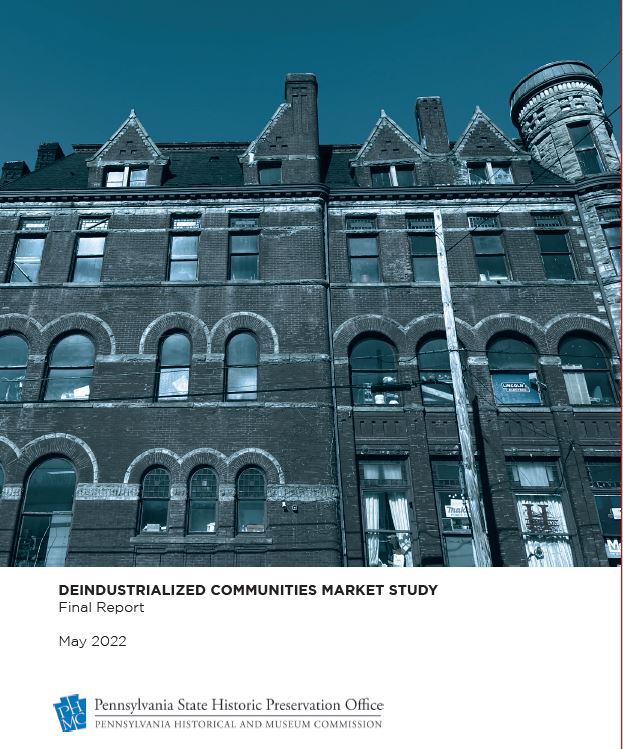
What is a Deindustrialized Community?
A deindustrialized community is one that has lost its economic foundation, one that was rooted in a single heavy manufacturing industry like steel. The study focused on twelve communities but considered the regional effect deindustrialization has had on local economies.
In these places, which typically experienced their economic heydays from the 1930s through the 1970s, heavy industry employed most of the community, who in turn supported the local businesses, schools, municipal services, churches and more. Beginning in the 1970s, companies began to close these manufacturing bases and communities found themselves in crisis without their largest employer and economic driver.
While their large urban counterparts (for example Pittsburgh or Buffalo, NY) have received much of the attention and press, small cities and boroughs have also experienced such loss and the accompanying ripple effects of declining populations, aging infrastructure, and a shrinking tax base. However, these smaller communities have held strong to their individual identifies and regional cultures. A significant part of this identity is embodied in the historic downtowns and properties that survive along their commercial main streets.
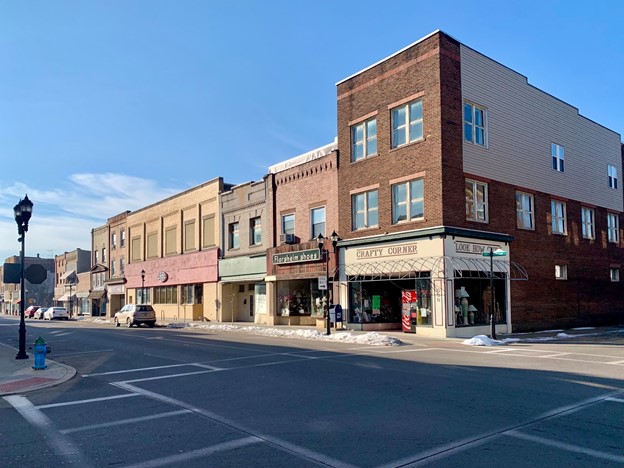
Why read this study?
Community leaders, elected officials, planning professionals, community residents and others can take this study and apply it in their communities immediately. It provides the evidence and inspiration needed to think about real community change.
The DCMS provides real data and direction for local, regional, and statewide decision makers. Use of this data and implementation of these directions will help create market-oriented opportunities while simultaneously helping preserve the identity-defining characteristics of these downtowns.
What is the Deindustrialized Communities Market Study?
The DCMS explores the economic development and community revitalization opportunities presented through the implementation of a preservation-focused design ethic in twelve deindustrialized riverfront municipalities in the Monongahela River and Beaver & Ohio River valleys in southwestern Pennsylvania:
- Aliquippa, Ambridge, Beaver, Beaver Falls, Midland, Monaca, New Brighton, Rochester in Beaver County,
- Charleroi, Donora, Monongahela in Washington County,
- Monessen in Westmoreland County.
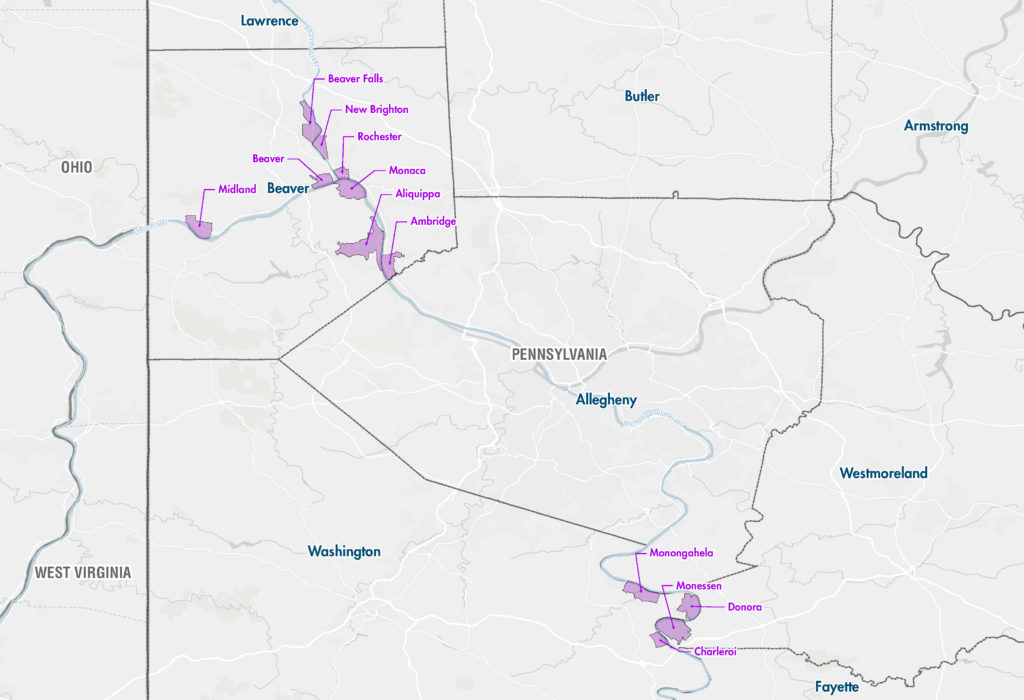
PA SHPO contracted with firms AKRF and evolveEA to complete this study, which is one component of PA SHPO’s investment in the region as part of the Shell petrochemical plant mitigation. Other PA SHPO projects include a preservation plan and design guidelines for Beaver Borough and historic resource surveys of the communities selected for this study. These surveys provided the data about historic places used in the market study.
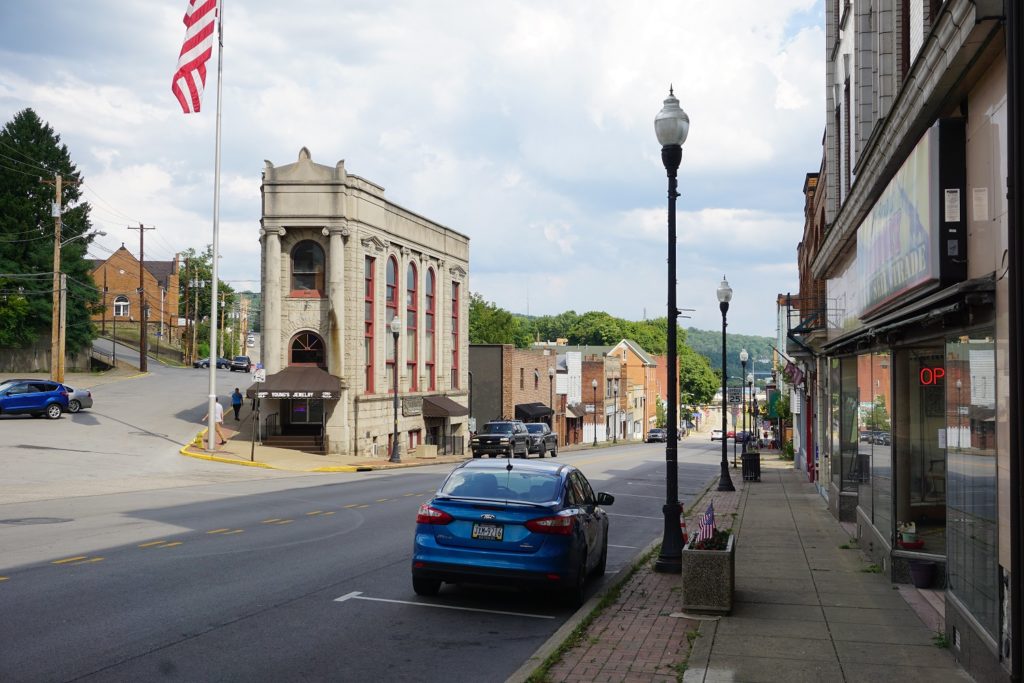
To complete the study, the project team did the following:
- engaged residents and local and regional stakeholders using a crowd-sourcing website, virtual public meetings, interviews, and focus groups (see page 22 and Appendix A: Stakeholder Summaries),
- completed community profiles with demographic and workforce and flood risk assessments (see Chapter 1, Appendix B: Community Profile Tables, and Appendix C: Flood Risk Maps),
- reviewed existing planning resources and documents to understand the context of planning in these regions and communities (see Chapter 2 and Appendix D),
- examined challenges and opportunities presented by barriers to historic property investment (page 20), blight (page 81), the COVID-19 pandemic (page 137), flood mitigation (page 194) and creating inclusive communities (page 202),
- performed a Market Demand Analysis (Chapter 3 and Appendices E-1 and E-2),
- identified key opportunities for each community (see Chapter 4),
- developed recommendations that offer implementable steps for communities to adopt (see Chapter 5).
How is this study different?
This study is different because of its geographic and subject matter focus. Rather than looking at the factors and forces influencing economic development and local planning in a single community, this study focuses on two distinct regions with several deindustrialized communities. Additionally, the economic opportunities created by historic buildings is rarely, if ever, considered in broader market analyses.
This means the DCMS includes more inclusive data for a better understanding across several municipalities of how an economic development strategy might work. Older studies and narrowly focused studies are not as replicable for other municipalities and regions as this one is.
What does this study say?
Each of the historic commercial districts in the study communities – whether they are thriving today or not – have real, tangible assets. Economist and former real estate developer Donovan Rypkema has demonstrated that historic buildings have an inherent competitive advantage over their newly-constructed counterparts.[1]

This study builds on that premise and shows that historic commercial districts and key historic buildings in these deindustrialized communities can be leveraged to realize untapped economic potential. Importantly, it provides strategies for investment that implements a design ethic sensitive to local history and tradition as a pathway for economic development.
For example, the Market Gap Analysis (beginning on page 103) illustrates the opportunity for historic buildings in the historic downtowns of the study communities: create niches for market investment that address unmet consumer needs. This analysis identifies the type and amount of development and/or investment that may potentially be supported by the existing market.
The consultant team established primary and secondary trade areas for each of the river valley regions. Within these areas, they evaluated the leakage and surplus factor by each major retail industry (for example, car dealers, restaurants, liquor stores and beer distributors, department stores, florists, etc.).
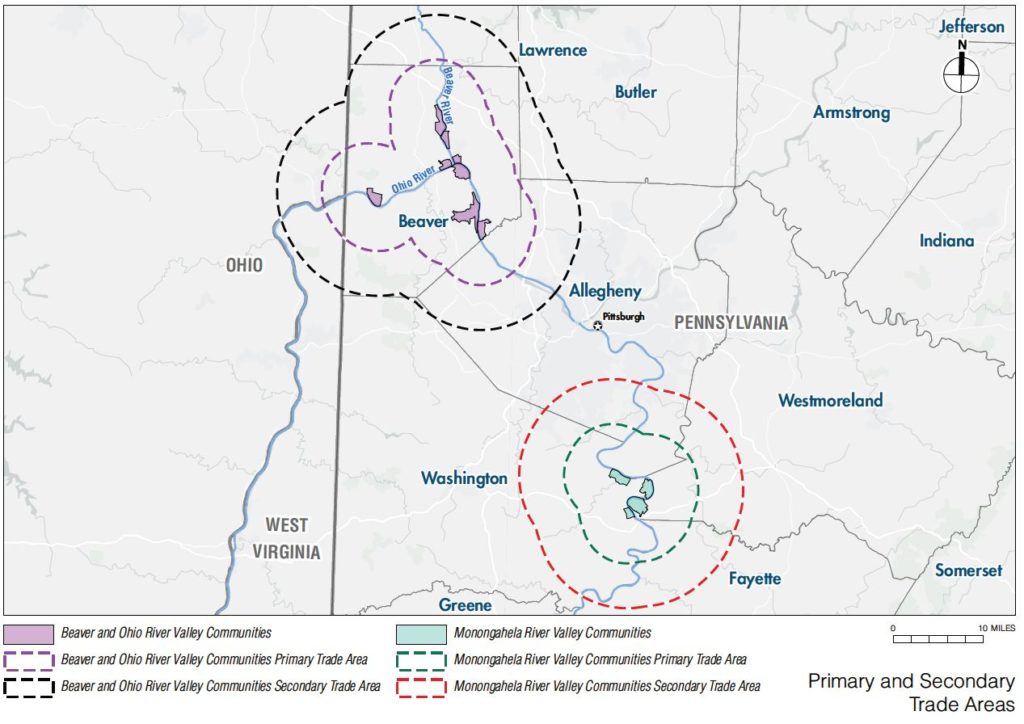
Leakage (-) is unmet retail potential, meaning residents of these communities are purchasing these retail goods and services but it is outside of the trade area. Surplus (+) is more supply than demand for these retail goods and services within the trade area.
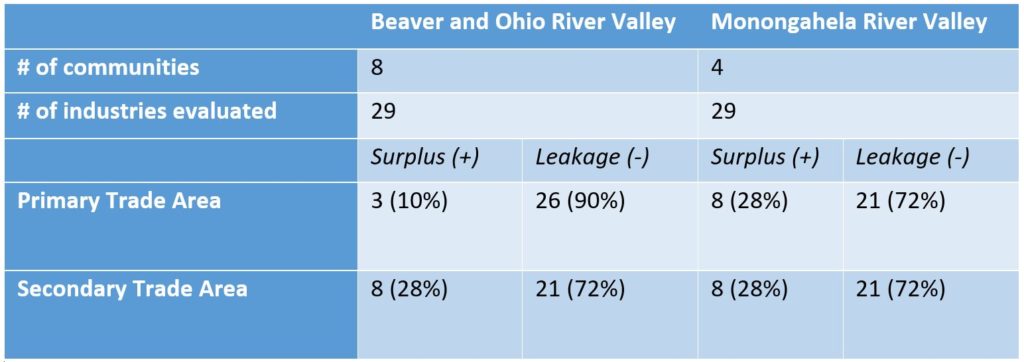
The data, very briefly summarized here, shows significant retail opportunities for these communities. Residents of the 12 study communities are purchasing these goods and services – just not in their hometowns. Economic development that brings those goods and services back to those historic commercial downtown buildings can succeed by meeting that market demand.
What does the study recommend?
The study includes a comprehensive set of recommendations and implementation strategies that are applicable to PA-SHPO and other state agencies such as DCED, DCNR, and PennDOT, county and regional planning agencies, municipal governments, and non-profit organizations focused on community development and historic preservation.
In chapter 4, the consultant team outlines specific recommendations for commercial districts in each community and provides an example of what is possible for a key historic building in each (beginning on page 142).
In Chapter 5 (starting on page 206), there are 13 broader recommendations for community development, which are largely informed by the results of the study’s public engagement process. Each recommendation includes an explanation for why the recommendation was made and how communities can act.
The implementation checklist (beginning on page 219) can help municipalities and their partners realize progress in ongoing, short-term, mid-term, and long-term increments.
What’s next?
PA SHPO will continue to work closely with the study communities, local and regional stakeholders, state agencies, and others to implement the recommendations of this study.
The next steps will depend largely on what each community chooses to embrace from this plan as part of their 21st century economic development strategy. It is not for PA SHPO to decide what is right for these communities, but we have provided the tools in this study to help them achieve their revitalization goals while maintaining community character and identity
If you would like a copy of this study or more information about this study or utilizing historic preservation as part of your community’s economic development strategy, please contact PA SHPO’s Bill Callahan, Western Region Community Preservation Coordinator, at wcallahan@pa.gov or Elizabeth Rairigh, Preservation Services Manager, at erairigh@pa.gov.
[1] Rypkema, Donovan. 1999. “Culture, Historic Preservation and Economic Development in the 21st Century.” Paper Submitted to The Leadership Conference On Conservancy And Development.
Leave a Reply